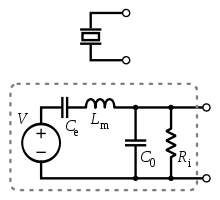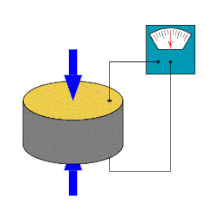Piezoelectric sensor
Piezoelectric sensors work with the piezoelectric effect and have proven to be a universal instrument for measuring various processes. They are used to determine pressure , acceleration , tension , force or as a gas sensor in quality and process control.
Applications
Many living things use piezoelectricity in a certain way: bones act as a force sensor . When force is applied, bones produce electrical charges in proportion to the internal loads. These charges stimulate and cause the formation of new bone material, which leads to a strengthening of the bone structure in the places where the internal deformations are greatest. This leads to load-specific minimal structures and thus an excellent ratio of weight to strength.
It took some time from the Curie brothers' discovery of the piezoelectric effect to its industrial use in sensor applications. This measuring principle has only been used since the 1940s and today represents a mature technology with outstanding inherent reliability; The piezo effect is used successfully in numerous critical areas of application, such as medical, aerospace or nuclear technology.
The rise of piezoelectric technology is due to a number of inherent advantages . The high modulus of elasticity of many piezoelectric materials is comparable to the modulus of elasticity of many metals and reaches up to 10 5 N / mm². Although piezoelectric sensors are electromechanical systems that respond to pressure, the measuring elements show almost no deformation (typically the measuring elements are only compressed by a few micrometers).
This is one reason for the robustness of the piezoelectric sensors, the very high natural frequency and the excellent linearity even under difficult operating conditions. In addition, piezoelectric technology is insensitive to electromagnetic fields and radiation. Some of the materials used - in particular gallium phosphate and tourmaline - have excellent stability over wide temperature ranges, which enables piezoelectric sensors to measure up to almost 1000 ° C. In addition to the piezo effect, tourmaline also has a pyroelectric effect. This effect also occurs with all piezoceramics (e.g. PZT ).
A disadvantage of piezoelectric sensors is their poor suitability for use in purely static measurements. A static force leads to a defined amount of charge on the surface of the piezoelectric material. If this charge is not measured with a charge amplifier but - technically incorrect - with an impedance converter , charges are continuously lost, which ultimately leads to a continuous drop in the signal. Increased temperatures produce an additional drop in internal resistance , so only materials with a high internal resistance can be used for such measurement conditions.
It would be wrong to assume that piezoelectric sensors can only be used for very fast processes or under moderate conditions. There are a large number of applications in which measurements are carried out under quasi-static conditions; there are also sensors for pressure measurements above 500 ° C.
functionality

Depending on the cut of the piezoelectric material, a distinction can be made between three main effects and thus modes of operation: transverse, longitudinal and shear effects:
- Transversal effect
- A force is applied along a neutral axis (y) and charges are applied in the (x) direction; to y; generated. The level of the charge depends on the dimensions of the respective piezoelectric element. If , , the dimensions are, then:
- ,
- being parallel to the neutral axis (y) and parallel to the charge generating axis (x). is the piezoelectric coefficient for this effect.
- Longitudinal effect
- The amount of charge generated is directly proportional to the force applied and independent of the size or shape of the piezoelectric element. The use of several elements connected mechanically in series and electrically in parallel is therefore the only way to increase the amount of charge. The resulting charge is:
- ,
- where is the piezoelectric coefficient ( pC / N ) for the generated charge on the x-face when the force is introduced parallel to the x-axis [N]. corresponds to the number of elements connected in parallel.
- Shear effect
- The generated charge is directly proportional to the force and is independent of the size or shape of the piezoelectric element. For elements connected mechanically in series and electrically in parallel, the charge is:
- .
In contrast to the longitudinal and shear effects, with the transverse effect the amount of charge generated (sensitivity) can be changed via the ratio of width (a) to height (b) of the crystal element. For this reason, most pressure sensors are based almost exclusively on the transverse effect.
Sensor design
Based on piezoelectric measurement technology, numerous physical quantities such as pressure and acceleration can be measured. For pressure sensors, a thin membrane of known dimensions and a solid base is used to ensure that the pressure loads the elements in a targeted manner in one direction. With accelerometers, a seismic mass is connected to the crystal elements. When the accelerometer senses movement, the seismic mass loads the elements according to Newton's second law of motion .
The main difference in how the two sensors work is the way in which the force acts on the measuring elements. In a pressure sensor, a thin membrane is used to deliver the force to the elements. In accelerometers, the force is exerted by a seismic mass.
Sensors often tend to respond to more than one physical quantity. Pressure sensors show a signal when accelerating because their membrane has a mass. Modern pressure sensors can be built acceleration-compensated. This compensation is based on the fact that the actual measuring element measures both pressure and acceleration processes. A second measuring element is arranged in the sensor in such a way that it only perceives acceleration processes. To obtain the “true” pressure value, the acceleration signal of the additional elements is subtracted from the combined signal of the actual (combined) pressure signal.
materials
Two main groups of materials are used for piezoelectric sensors: piezoelectric ceramics and monocrystalline materials. Ceramics (e.g. PZT ceramics) have a piezoelectric constant which is two orders of magnitude higher than that of crystal materials and which can be produced in a sintering process . However, the high sensitivity is associated with poor long-term stability. Piezoelectric ceramics are therefore mostly used when the requirements for measurement accuracy and long-term stability are not too high. Less sensitive monocrystalline materials ( quartz , tourmaline and gallium phosphate ) have significantly higher - and almost infinite - long-term stabilities.
Standards
Web links
- Piezoelectric sensors. In: Website of Piezocryst Advanced Sensorics GmbH. Archived from the original on August 12, 2012 ; Retrieved September 10, 2007 .











